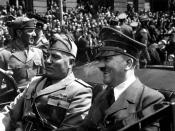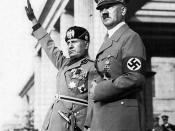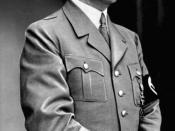Fascism is best defined as a form of government which is ruled by a dictator who holds very strong nationalistic views. The major characteristics of fascism consist of the government having total control over industry, religion, culture, social activities and economic factors. Fascism has been said to be similar to communism, however the difference is that private ownership still remains. Fascism has occurred throughout the world in countries such as Italy, Germany and Spain. Benito Mussolini was the Fascist dictator or Duce in Italy and lead them into their period of fascist rule in 1922, this ended in 1943. Adolf Hitler was the fascist dictator of Fuehrer who lead Germany into their fascist period in 1933. Fascism remained in Germany until the end of the Second World War in 1945. Between this time period Adolf Hitler had total control over the entire German state. He kept his power through the success and use of the Nazi party.
Through Hitler's leadership he was able to keep a strong hold on Germany by the use of fascist ideology, his dictatorship, creating a one party state and moulding his master race.
During Hitler's reign he used his strong fascist ideology to keep a tight hold on the German nation. Hitler looked up to Benito Mussolini for much of his political life, therefore it has been said that much of Hitler's fascist ideas came from his admiration of Mussolini. Hitler's Fascist ideology could be broken down into fourteen points. Hitler was extremely nationalistic he believed that Germany was superior to all other nations and that his countries needs were more important than any others. Hitler also showed people that the human rights of others could be neglected if it was to mean achieving something of importance. This particular view enabled Hitler to persecute people...


